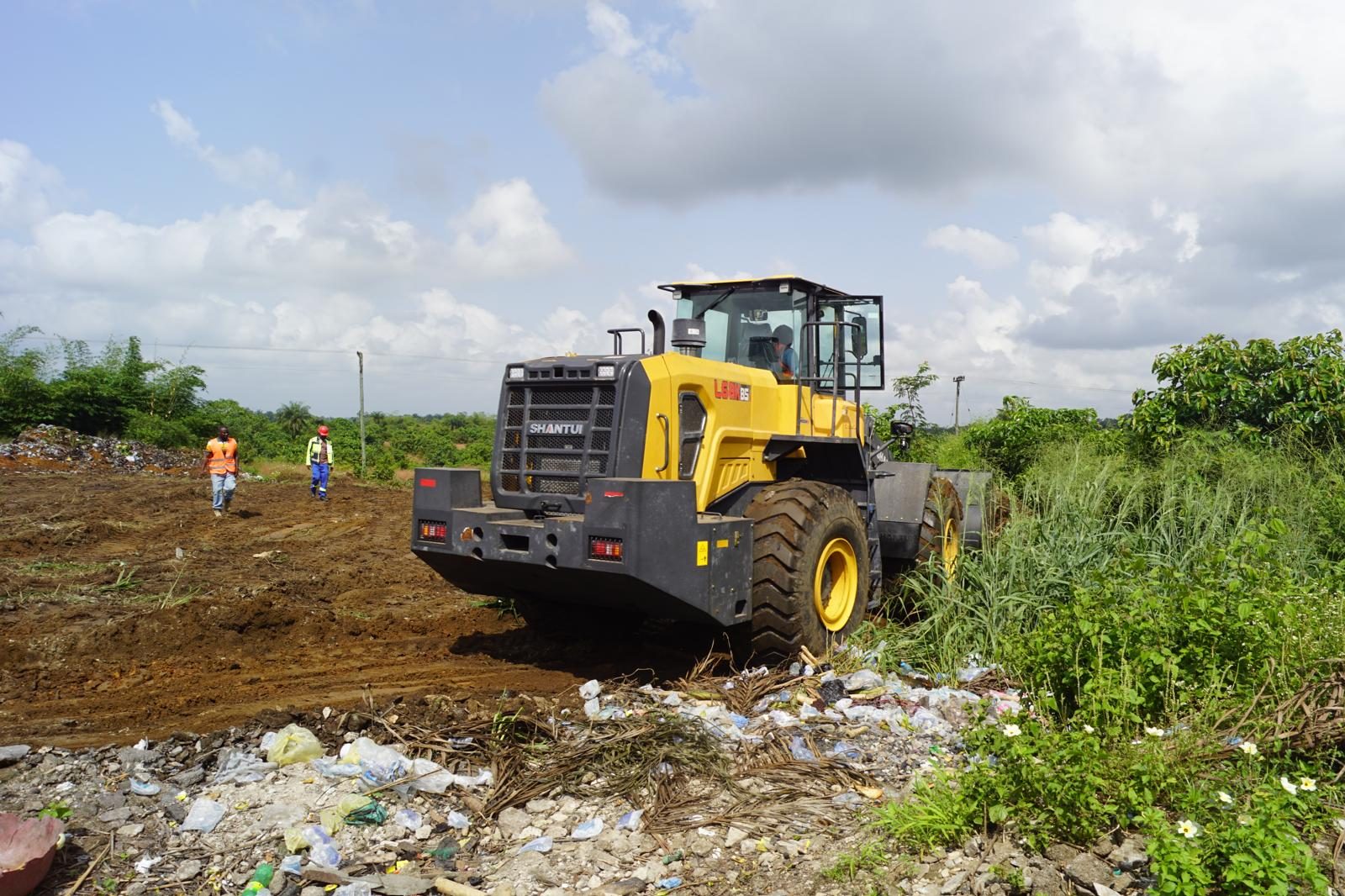Fendall Campus, Nov. 22, 2025| The University of Liberia is embarking on a US $680,000, solar-powered infrastructure project that will provide vital utilities round-the-clock and transform 1.5 acres on Fendall campus into a model of sustainability and student innovation.
The Solar Oasis Student Utility Park, a state-of-the-art project, will feature a bathroom complex with 20 new hygienic stalls (10 toilets and 10 urinals with disability-accessible stalls), a mini Student Center and an outdoor water fountain. The development will directly address longstanding bathroom and sanitation needs on the campus; provide free filtered drinking water; and create a crucial student hub, offering Wi-Fi, charging stations, printing services and space for study and connection.
Furthermore, the entire project marks UL’s first foray into solarization. The utilization of renewal energy at the self-contained site will ensure 24/7 electricity, running water, sanitation and Wi-Fi. The initiative could serve as a blueprint to eventually solarize all four campuses of UL— a move that could transform the university, relieving it of the chronic infrastructure issues that have stymied its progress.
“The Solar Oasis Student Utility Park is going to be a game-changer for UL,” said UL President Dr. Layli Maparyan.
The President said the lack of stable electricity, water and sanitation have undermined UL’s role as the nation’s flagship university, leaving it unable to fulfill its core mission of educating Liberian students and aiding national development.
“This requires educational facilities that allow our students to access the most up-to-date educational resources, most of which are digital, and to sit in a conducive learning environment,” she said. “We can’t do this without consistent 24/7 current, 24/7 water, 24/7 sanitation facilities, and 24/7 internet access. We want to provide a world class education, but we can’t do that without this sound basic infrastructural foundation.”
She added: “Solarization is a commitment to making this future possible and leaping forward technologically while, at the same time, capitalizing one of Liberia’s most plentiful natural resources, namely, sunshine. For these reasons, I am proposing to solarize all 4 of UL’s campuses.”
Pilot Project for Campus-wide Solarization at UL
Dr. Maparyan said the Solar Oasis project is a pilot initiative – the first step in alleviating the electricity and sanitation issuesvia solar before expanding it to other campuses, paving the way to embark on efforts that’ll make UL a world-class university.
In addition to bringing steady power and clean water to the area, using high-output solar technology, the project features modern, cutting-edge construction, technological advancement, environmentally soundness, and a relaxing, peaceful environment conducive to studying as well as health and wellness, the President said.
“Students who feel good will be energized to learn, dream, innovate, and make the most of their education. This new structure will turn the tide on the student experience,” she said. “The Solar Oasis is going to set a new standard for infrastructure improvements at UL. It will position us to dream big but dream efficiently and sustainably. It will widen the imagination.”
Liberian-led Engineering, High-grade Solar Technology
Adding further significance to the project is the Liberian-owned company that’s designing, installing and building the project:Xity Engineering Solutions, a Johnsonville-based company, providing solutions in commercial and industrial solar power. The company’s CEO is Dr. Sannah Ziama, a former UL student who recently returned to Liberia after decades of advanced schooling and professional work as a physicist in academia and tech sector in the United States. Most recently he worked as a senior AI scientist at Amazon.

Dr. Ziama said UL’s bathroom shortage and infrastructure issues stretched generations, and a lasting solution to the problem is overdue.
“The restroom challenge has existed here for quite a long time now,” Dr. Ziama recalled. “It was a problem when I was a student at the Capitol Hill campus over two decades ago and potentially was a problem before I enrolled … I can easily empathize with students who face it today, and this compels me to make personal sacrifices for a higher degree of quality of the delivered solution.”
Dr. Ziama conceived and designed the Solar Oasis project. And its solar micro grid is advanced, contains top-of-the-line components and boasts a longer life span and capabilities beyond the systems typically installed in Liberia.
“We’re using renewable energy as the force that brings life to the Solar Oasis,” Dr. Ziama said. “This is a project where solar is first-class citizen. That means we designed everything around solar. Not only other universities, but schools, hospitals, businesses and particularly public entities should think about integrating solar into existing power supply or when building newly, design with solar as the main source of power. It’s more economical in the long run and provides reliability and peace of mind that are unmatched by customary options.”
The system is industrial grade solar, instead of the commonly used residential, and its solar panels can potentially generate excessive electricity enough to sell to LEC; and its long-lasting battery can run the site for two days during inclement weather.
Dr. Ziama said the project is also unique because of its focus.
“But this is a good thing because it allows the UL to, for the first time in Liberia’s higher education space, demonstrate that students’ campus-life can be a whole lot improved by utilizing solar,” he said. “Additionally, it also serves to be a pilot for the bigger aspirations of President Maparyan to power the entire existing Fendall campus and future expansion plans with solar.”
Transforming Student Life, Restoring Dignity
The Solar Oasis will be situated between the basketball court and the engineering building on Fendall Campus. The site – 1.5 acres – has already been cleared for the construction of the bathroom complex – consisting of two buildings, the Student Center, the Water Fountain square and the Utility Building. The work is underway and is slated to be completed in eight months.
UL student Vashe T. Weah expressed excitement about the project, saying it’s a “real investment in students’ dignity and comfort.”
“Having 20 modern bathrooms, including disability-accessible ones, set in a calm, park-like space shows that the University is thinking about the everyday needs of all students,” said Weah, the reigning Miss Inter-University queen. “And the mini StudentCenter with 24-hour charging, laptop docking, Wi-Fi and clean drinking water is a huge boost. These are the small supports that actually make student life easier.”
Weah works to make feminine products available in the University’s female restrooms through her SheShelter Initiative. She said the Solar Oasis project aligns with her mission.
“So, seeing the University of Liberia, under the leadership of Dr. Layli Maparyan, prioritizing hygiene, safety and student wellbeing gives me hope that we’re moving in the right direction,” Weah said.
Proof of Concept to Attract Green and Development Finance
The project costs US $680,000. Dr. Maparyan said project is being funded by UL “with portion of the set-asides for bathroom renovation and some anticipated climate-specific funding in UL’s FY 2026 budget.” She added a small amount of UL’sannual endowment distribution will be used to cover the costs.
While the Solar Oasis Student Utility Park is a small, site-specific pilot serving one corner of campus, it will serve as proofof concept to garner funding for future solarization at UL. The President said there is interest among energy and environmental funders and others. Bank financing might be an option too.
“Grantors and investors in large scale projects want to see ‘proof of concept’ before providing funds,” she said. “The Solar Oasis Student Utility Park will serve as both a solarization pilot project and a ‘proof of concept’ for donors and other funders. With this build completed and the project up and running, UL will be better positioned to attract funds from global green energy funders and development finance organizations for the campus-wide solarization project.”

